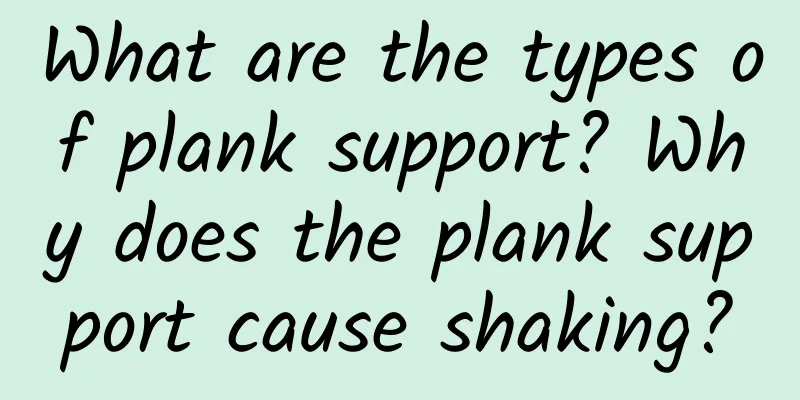What are the types of plank support? Why does the plank support cause shaking?

|
In fact, the longer you do the plank, the better. You just need to practice according to your own physical condition. There is no such thing as how long you have to do it to pass or how long you have to do it to see the effect. Because the plank is not an aerobic exercise, but a static resistance exercise, it does not need to follow the rule that aerobic exercise must be exercised for more than half an hour to be effective. It is just an auxiliary exercise, and you can do it in a variety of ways, such as floating plank, hip swing plank, starfish plank, pay attention to the key points of the movement when exercising, and do not fatigue the entire motor nervous system. Contents of this article 1. What are the types of plank support? 2. Essentials of plank support 3. Why do planks cause shaking? 1What are the types of plank support?1. Floating plank Bend your elbows under your shoulders, stretch your legs backward, touch the ground with your toes, keep your back flat, palms facing up, thumbs facing both sides, and use your elbows to support your whole body; lift your hips up, head pointing to the floor, spread your hands to the left and right, and make your whole body an inverted V shape. Push forward with your ankles, lower your hips and retract your hands, return to the starting position, and repeat five times. This movement can not only adjust a person's balance, but also mobilize the core muscles to improve fitness efficiency. 2. Hip-shaking plank Bend your arms and place your elbows under your shoulders, stretch your legs backwards, touch the ground with your toes, keep your back flat, palms up, thumbs facing sides, keep your head still, back straight, and swing your hips from left to right. You can move the arm on the same side as your hips. Repeat several times in total, half on each side. 3. Starfish Plank Bend your arms and place your elbows under your shoulders, straighten your legs backward, toes touching the ground, keep your back flat, palms up, thumbs facing sides, and legs shoulder-width apart. Then gradually shift your center of gravity to your elbows and toes on the same side, so that the plane of your body is perpendicular to the horizontal. Then straighten your unsupported hand and lift the leg on the unsupported side as high as possible. Hold for one minute each time, then repeat with the other side. 2Essentials of plank supportKeep your elbows and shoulders at right angles to your body. Lie facedown on the floor, supporting your weight on your toes and forearms. Bend your arms and place them under your shoulders. Keep your body straight at all times and hold this position for as long as possible. To increase the difficulty, you can raise your arms or legs. Keep your shoulders above your elbows, keep your abdominal muscles contracted and exerting force (under control), keep your hips no higher than your shoulders, and keep your feet shoulder-width apart. You can put your hands together, and raise your hips appropriately when you hold for more than 75 seconds (because our hips will sink over time, so we need to keep our hips, waist, and legs in a straight line). Keep your neck tilted forward to exercise your neck. 3Why do planks cause shaking?1. Insufficient muscle strength Our muscles will become tense and congested through exercise. At this time, blood will fill the muscle fibers, making them feel expanded and oxidized at the same time. However, some people's muscle strength is not strong yet, and their muscle fibers have not reached that level, but the intensity of the plank they do exceeds what they can bear. Therefore, the blood will not be able to complete oxidation metabolism in the muscle tissue and cannot expand and circulate in the muscle fibers well, because the muscle space you provide for it is not enough, that is, it is not developed enough. So people will shiver involuntarily. This is a very normal phenomenon, don't worry, just don't do it too much in the future. Also, it is best to do plank support as the degree of muscle development increases. Generally, the waist, abdomen, lower back or thighs will shake. The specific part that shakes most strongly is the weaker part. If it is more in the waist and abdomen, it means that the core strength is insufficient. Strengthen the exercise and it will eventually improve. This is also the reason why after adding abdominal exercises to strengthen the abdominal strength, the plank support will become easier and easier to do for a longer time. In fact, the longer you do plank support, the better. You just need to practice according to your own physical condition. There is no such thing as how long you have to do it to pass or how long you have to do it to see the effect. Because plank support is not an aerobic exercise, but a static resistance exercise, you don't need to follow the rule that aerobic exercise must be exercised for more than half an hour to be effective. 2. Too little exercise The contraction of the abdominal muscles during plank support is very unique. The muscles are stretched when relatively still, and are isometrically contracted at the same time. Therefore, it trains the nervous system more than muscle circumference. If you don't practice it often, your neural pathways will not be smooth. The nervous system needs to recruit more muscle fibers to participate, and if the recruitment is not in place, of course the shaking will occur. In the final analysis, this is because the muscles are not strong enough due to lack of exercise. In this case, just keep practicing more. Also, you can keep shaking, but it is recommended to keep shaking for 10-20 seconds and stop, so as to avoid compensation. 3. Excessive muscle tension The body shaking while doing plank support may also be caused by excessive muscle tension or the muscle force reaching the current personal strength limit. Some people are too tense when doing plank support and use their arms too hard. At this time, it is recommended to use low options, knees on the ground. After a period of other abdominal and core training, the core strength is strengthened and then choose difficult and long-term movements. At the same time, it is recommended to cooperate with other crunches while doing plank training, and do aerobic warm-up 10-15 minutes in advance. Doing some warm-up exercises in advance can help relieve the tension of the muscles when doing plank support later. In isometric strength exercises such as plank, although the muscle length remains unchanged, the muscles need to remain contracted all the time. Over time, this can easily cause fatigue in the entire motor nervous system. Fatigue will cause the production and release of chemicals needed to transmit electrical impulses to fail to keep up with the level of muscle activity. The inability to transmit electrical impulses will cause more and more motor units to stop working. The previously stable and continuous muscle contraction will become less synchronized, and the muscle will tremble. This phenomenon can be improved through long-term exercise in the future. |
>>: How to make grilled fish? How to make grilled fish with pickled cabbage flavor on paper?
Recommend
Brown discharge after taking Yasmin
In order to improve the quality of sex life, nowa...
Can I eat dried red dates during early pregnancy?
It is actually a very happy thing for pregnant wo...
Why is the ovulation test paper dark on the top and light on the bottom?
There are many ovulation test strips on the marke...
Can I keep the baby after two months of pregnancy?
Natural childbirth is the method of delivery that...
Five tofu recipes for weight loss, losing weight is no problem!
Tofu is a food that many people love to eat in li...
How can I get pregnant if the follicles are not developing well?
The follicles play a vital role in our difficult ...
This kind of sugar is a hidden "health killer". Many people eat it almost every day, but they don't know it.
With the popularization of health concepts, peopl...
I feel irritable after pregnancy, it means it's a boy
Many expectant mothers experience irritability du...
What is conception day?
The day of conception is actually the day of ovul...
Picture of baby in one month of pregnancy
Generally speaking, women are always paying atten...
What causes polycystic ovary syndrome
Polycystic ovary syndrome is mainly caused by pro...
Should I walk or lie down after the abortion injection?
Induced abortion actually mainly refers to a meth...
What is peach gum made of? Should peach gum be soaked in cold water or hot water?
Peach gum, also known as peach oil, peach fat, pe...
Are men who love to say sweet words too greasy? How can you tell if a man's sweet words are sincere?
It is normal for a man to say a lot of sweet word...
Young people are the biggest victims of depression! Experts call for global action
Written by: Wang Haha Layout: Li Xuewei It is est...









